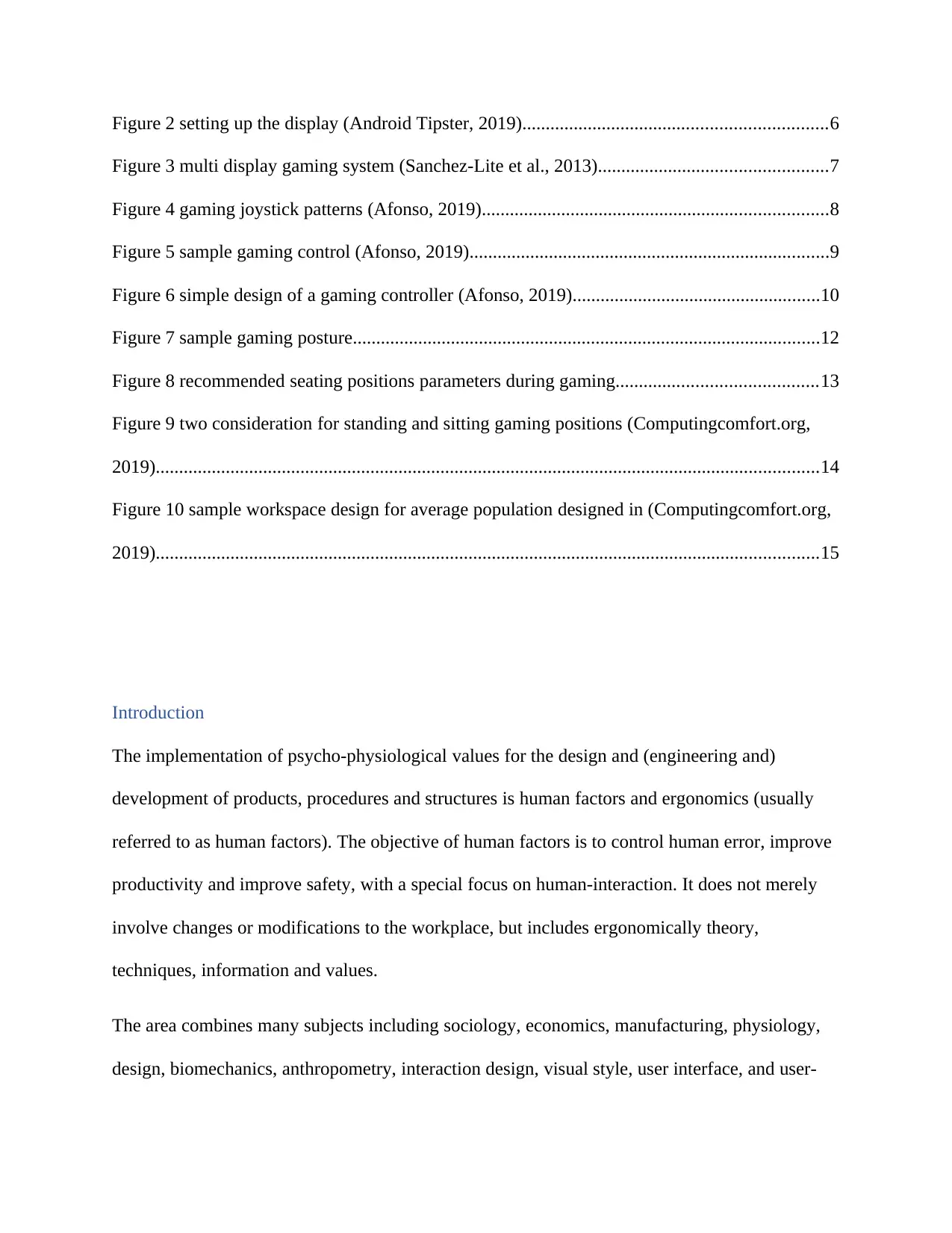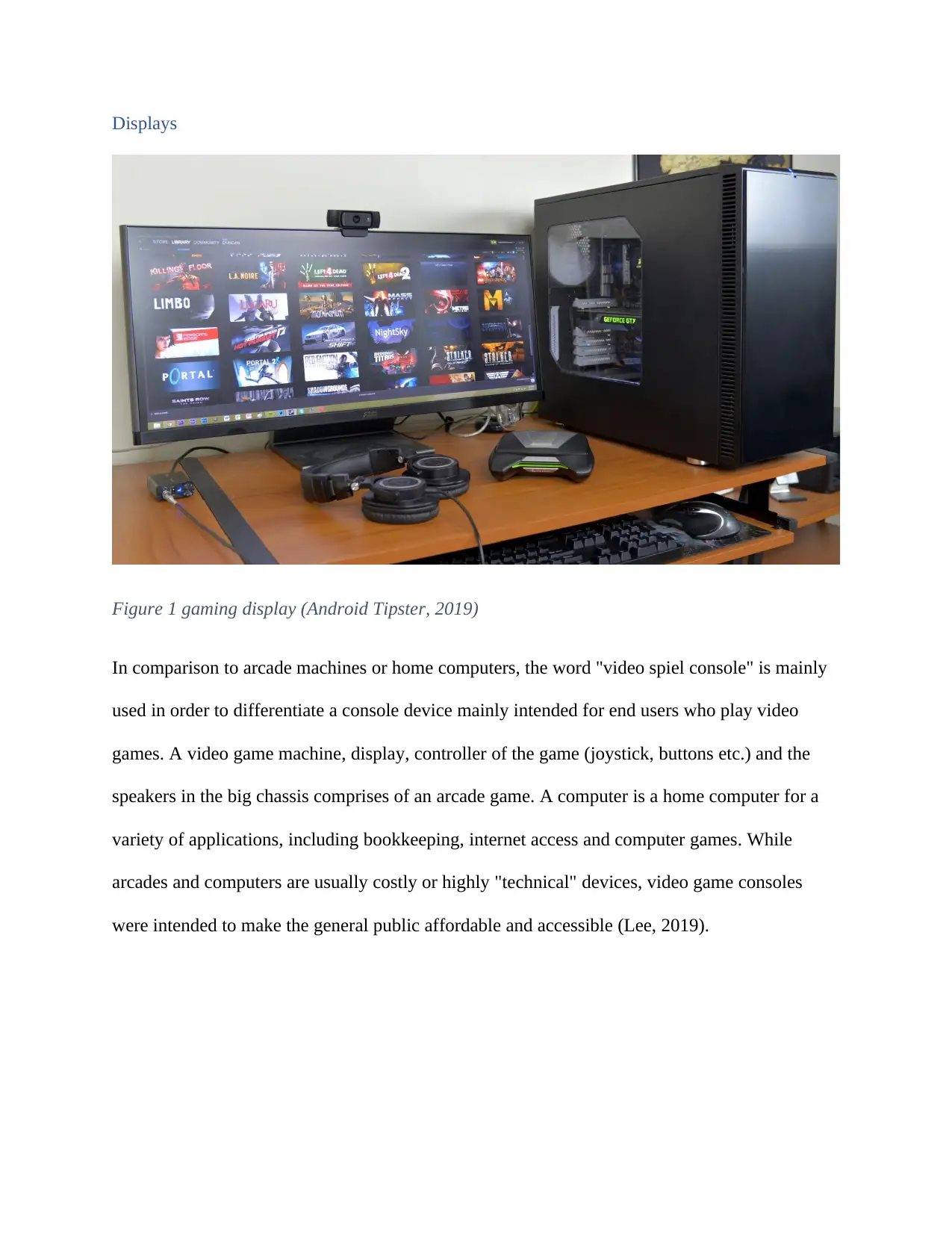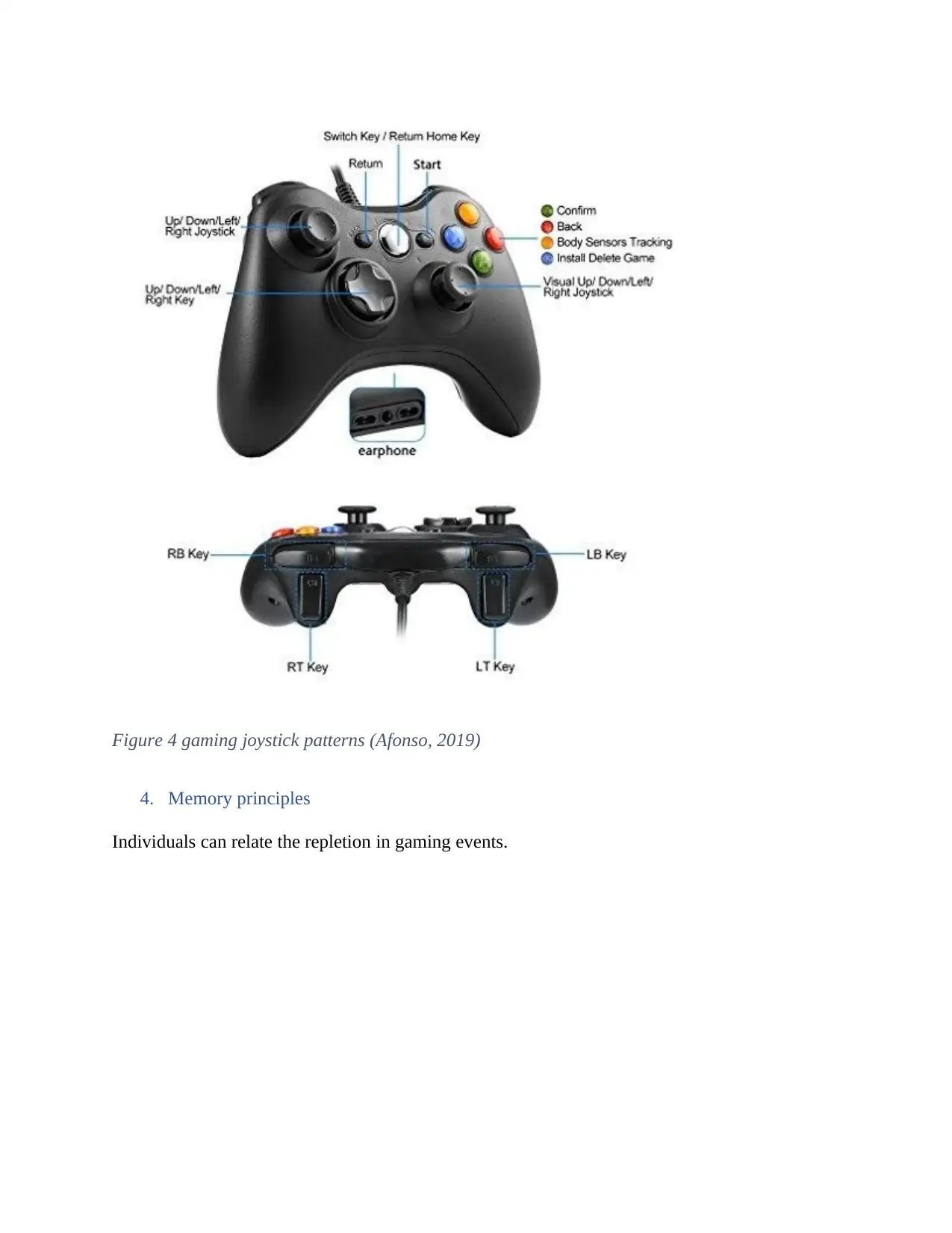Ergonomic Considerations in Gaming System Design: A Detailed Analysis
VerifiedAdded on 2023/03/17
|21
|2809
|74
Report
AI Summary
This report delves into the crucial human factors and ergonomic considerations in the design of gaming systems. It begins by defining the importance of comfortability and user experience, then proceeds to analyze various aspects of gaming systems, including displays, controls, and workspace design. The report explores perceptual principles, attention-based design, Gestalt principles, and memory principles as they apply to gaming displays. It examines the design of gaming controllers, focusing on recognition, response selection, and continuous control. Furthermore, the report discusses anthropometry and workspace design, including anthropometric tables, link analysis, spatial organization, and component layout. The study emphasizes the need for ergonomic design to improve user experience and prevent potential health issues. The report concludes by highlighting the importance of considering these human factors to create gaming systems that are both enjoyable and safe for players. All this information and more can be found on Desklib.

Human Ergonomic factors in Gaming system
Student name
Course title
Lecturer
Institution
Student name
Course title
Lecturer
Institution
Paraphrase This Document
Need a fresh take? Get an instant paraphrase of this document with our AI Paraphraser

Abstract
The role of this paper is to discuss human factors to consider in designing a gaming system. A
good gaming system should meet adequate requirements of comfortability. A gaming console is
a device to display a video signal or visual image for a video game that can be played by one or
even more people.In comparison to arcade machines or home computers, the term ' video game
console' is used mainly for distinguishing between consoles designed primarily for consumers
who play computer games. An arcade device has a video game, a show, a DualShock controller
(stick, buttons, etc.) and large powertrain amplifiers. A computer is a home computer for a
variety of purposes, for example accounting, Internet access and video gambling.
The role of this paper is to discuss human factors to consider in designing a gaming system. A
good gaming system should meet adequate requirements of comfortability. A gaming console is
a device to display a video signal or visual image for a video game that can be played by one or
even more people.In comparison to arcade machines or home computers, the term ' video game
console' is used mainly for distinguishing between consoles designed primarily for consumers
who play computer games. An arcade device has a video game, a show, a DualShock controller
(stick, buttons, etc.) and large powertrain amplifiers. A computer is a home computer for a
variety of purposes, for example accounting, Internet access and video gambling.

Contents
Abstract.......................................................................................................................................................2
Introduction.................................................................................................................................................4
Displays.......................................................................................................................................................5
1. Perceptual Principles.......................................................................................................................6
2. Principles based on attention...........................................................................................................7
3. Gestalts principles............................................................................................................................8
4. Memory principles...........................................................................................................................9
5. Mental model principles................................................................................................................10
Controls.....................................................................................................................................................10
1. Recognition...................................................................................................................................11
2. Response selection.........................................................................................................................11
3. Continuous control and tracking....................................................................................................12
4. Direct and indirect control devices................................................................................................13
5. Non-standard controls....................................................................................................................13
Anthropometry and workspace design.......................................................................................................13
1. Anthropometric table.....................................................................................................................13
2. Link analysis..................................................................................................................................16
3. Spatial organisation of workspace.................................................................................................17
4. Component layout..........................................................................................................................18
5. Analytical analysis.........................................................................................................................18
References.............................................................................................................................................19
Figure 1 gaming display (Android Tipster, 2019)...........................................................................5
Abstract.......................................................................................................................................................2
Introduction.................................................................................................................................................4
Displays.......................................................................................................................................................5
1. Perceptual Principles.......................................................................................................................6
2. Principles based on attention...........................................................................................................7
3. Gestalts principles............................................................................................................................8
4. Memory principles...........................................................................................................................9
5. Mental model principles................................................................................................................10
Controls.....................................................................................................................................................10
1. Recognition...................................................................................................................................11
2. Response selection.........................................................................................................................11
3. Continuous control and tracking....................................................................................................12
4. Direct and indirect control devices................................................................................................13
5. Non-standard controls....................................................................................................................13
Anthropometry and workspace design.......................................................................................................13
1. Anthropometric table.....................................................................................................................13
2. Link analysis..................................................................................................................................16
3. Spatial organisation of workspace.................................................................................................17
4. Component layout..........................................................................................................................18
5. Analytical analysis.........................................................................................................................18
References.............................................................................................................................................19
Figure 1 gaming display (Android Tipster, 2019)...........................................................................5
⊘ This is a preview!⊘
Do you want full access?
Subscribe today to unlock all pages.

Trusted by 1+ million students worldwide

Figure 2 setting up the display (Android Tipster, 2019).................................................................6
Figure 3 multi display gaming system (Sanchez-Lite et al., 2013).................................................7
Figure 4 gaming joystick patterns (Afonso, 2019)..........................................................................8
Figure 5 sample gaming control (Afonso, 2019).............................................................................9
Figure 6 simple design of a gaming controller (Afonso, 2019).....................................................10
Figure 7 sample gaming posture....................................................................................................12
Figure 8 recommended seating positions parameters during gaming...........................................13
Figure 9 two consideration for standing and sitting gaming positions (Computingcomfort.org,
2019)..............................................................................................................................................14
Figure 10 sample workspace design for average population designed in (Computingcomfort.org,
2019)..............................................................................................................................................15
Introduction
The implementation of psycho-physiological values for the design and (engineering and)
development of products, procedures and structures is human factors and ergonomics (usually
referred to as human factors). The objective of human factors is to control human error, improve
productivity and improve safety, with a special focus on human-interaction. It does not merely
involve changes or modifications to the workplace, but includes ergonomically theory,
techniques, information and values.
The area combines many subjects including sociology, economics, manufacturing, physiology,
design, biomechanics, anthropometry, interaction design, visual style, user interface, and user-
Figure 3 multi display gaming system (Sanchez-Lite et al., 2013).................................................7
Figure 4 gaming joystick patterns (Afonso, 2019)..........................................................................8
Figure 5 sample gaming control (Afonso, 2019).............................................................................9
Figure 6 simple design of a gaming controller (Afonso, 2019).....................................................10
Figure 7 sample gaming posture....................................................................................................12
Figure 8 recommended seating positions parameters during gaming...........................................13
Figure 9 two consideration for standing and sitting gaming positions (Computingcomfort.org,
2019)..............................................................................................................................................14
Figure 10 sample workspace design for average population designed in (Computingcomfort.org,
2019)..............................................................................................................................................15
Introduction
The implementation of psycho-physiological values for the design and (engineering and)
development of products, procedures and structures is human factors and ergonomics (usually
referred to as human factors). The objective of human factors is to control human error, improve
productivity and improve safety, with a special focus on human-interaction. It does not merely
involve changes or modifications to the workplace, but includes ergonomically theory,
techniques, information and values.
The area combines many subjects including sociology, economics, manufacturing, physiology,
design, biomechanics, anthropometry, interaction design, visual style, user interface, and user-
Paraphrase This Document
Need a fresh take? Get an instant paraphrase of this document with our AI Paraphraser

facet design. This is a combined field. Study uses a scientific process to understand human
behaviour in order to apply the resulting data to the four main objectives. Essentially it is the
research of devices, procedures and machinery that adapts to the body and to its cognitive
abilities. In essence, the two words "human" and "ergonomic" are interchangeable.
Computational modelling is used to achieve the safety and health and efficiency objectives of the
labour force. The structure of safe decor and simple-to-use interfaces to devices and machinery is
important.
Suitable ergonomics are needed in order to avoid repeated stress lesions as well as other
disorders of the neuromuscular muscles which can evolve over time and cause long-term
disabilities.
Extenuating factors and ergonomics relate to the "fit" between user, device and environment or
the "fit of a person for work." It takes into consideration users ' abilities and limitations to ensure
that tasks, functions, data and the environment are appropriate for the customer.
behaviour in order to apply the resulting data to the four main objectives. Essentially it is the
research of devices, procedures and machinery that adapts to the body and to its cognitive
abilities. In essence, the two words "human" and "ergonomic" are interchangeable.
Computational modelling is used to achieve the safety and health and efficiency objectives of the
labour force. The structure of safe decor and simple-to-use interfaces to devices and machinery is
important.
Suitable ergonomics are needed in order to avoid repeated stress lesions as well as other
disorders of the neuromuscular muscles which can evolve over time and cause long-term
disabilities.
Extenuating factors and ergonomics relate to the "fit" between user, device and environment or
the "fit of a person for work." It takes into consideration users ' abilities and limitations to ensure
that tasks, functions, data and the environment are appropriate for the customer.

Displays
Figure 1 gaming display (Android Tipster, 2019)
In comparison to arcade machines or home computers, the word "video spiel console" is mainly
used in order to differentiate a console device mainly intended for end users who play video
games. A video game machine, display, controller of the game (joystick, buttons etc.) and the
speakers in the big chassis comprises of an arcade game. A computer is a home computer for a
variety of applications, including bookkeeping, internet access and computer games. While
arcades and computers are usually costly or highly "technical" devices, video game consoles
were intended to make the general public affordable and accessible (Lee, 2019).
Figure 1 gaming display (Android Tipster, 2019)
In comparison to arcade machines or home computers, the word "video spiel console" is mainly
used in order to differentiate a console device mainly intended for end users who play video
games. A video game machine, display, controller of the game (joystick, buttons etc.) and the
speakers in the big chassis comprises of an arcade game. A computer is a home computer for a
variety of applications, including bookkeeping, internet access and computer games. While
arcades and computers are usually costly or highly "technical" devices, video game consoles
were intended to make the general public affordable and accessible (Lee, 2019).
⊘ This is a preview!⊘
Do you want full access?
Subscribe today to unlock all pages.

Trusted by 1+ million students worldwide

1. Perceptual Principles
The wording on the screen is legible, as seen in the home screen, as the letter size is sufficiently
great to make easy to understand, however the contrast between the letter width is not important.
Furthermore, the servers tend to read the screen by uniting the phrases (reading the form not the
word) that is appropriate to seasoned servers but not easy for unfamiliar people, thus affecting
the ability to select the right button. The bigger problem is each option is available backdrop
colours.
The perpetual displays will be based on customer preference. The designed gaming system for
PS4 gaming has visible setting buttons which are used to customize the screen.
The wording on the screen is legible, as seen in the home screen, as the letter size is sufficiently
great to make easy to understand, however the contrast between the letter width is not important.
Furthermore, the servers tend to read the screen by uniting the phrases (reading the form not the
word) that is appropriate to seasoned servers but not easy for unfamiliar people, thus affecting
the ability to select the right button. The bigger problem is each option is available backdrop
colours.
The perpetual displays will be based on customer preference. The designed gaming system for
PS4 gaming has visible setting buttons which are used to customize the screen.
Paraphrase This Document
Need a fresh take? Get an instant paraphrase of this document with our AI Paraphraser

Figure 2 setting up the display (Android Tipster, 2019)
Users can set their preferences to offset or meet their perpetual preferences
2. Principles based on attention
In gaming, the use of a double-monitor computer workstation is increasing, as our computer
becomes more central and paper material is mainly transferred to digital media. Counselling
regarding the ergonomics of a workspace with a dual monitor can be confusing.
The ergonomic advice centres on keeping a neutral neck stance as with a single-monitor
workstation. This can be difficult if you try to look at another screen or commonly switch around
screens.
The range between the 50/50 and 80/20 use for many individuals with dual monitors. In all those
cases, a scattered display must be placed along an arc between centre right (as used in 50/50) and
Users can set their preferences to offset or meet their perpetual preferences
2. Principles based on attention
In gaming, the use of a double-monitor computer workstation is increasing, as our computer
becomes more central and paper material is mainly transferred to digital media. Counselling
regarding the ergonomics of a workspace with a dual monitor can be confusing.
The ergonomic advice centres on keeping a neutral neck stance as with a single-monitor
workstation. This can be difficult if you try to look at another screen or commonly switch around
screens.
The range between the 50/50 and 80/20 use for many individuals with dual monitors. In all those
cases, a scattered display must be placed along an arc between centre right (as used in 50/50) and

the powerful eye (as in 80/20) all the way to a side of both the eye. The more you use the main
monitor, the nearer you are to the split.
Figure 3 multi display gaming system (Sanchez-Lite et al., 2013)
3. Gestalts principles
The laws from Gestalt clarify how we somehow view trends. Define patterns rely on the way our
brain manages our senses ' raw data, it uses cognitive sets a lot. Our brains are wired, although
there is no one, to put things that we see. You are always trying to bridge the discrepancies.
Recall to the right the illusion? Still, your brain fills the breakdowns and you see a grey and a
Caucasian triangle on the top 3 white circles (Tinker-entertainment.com, 2019).
monitor, the nearer you are to the split.
Figure 3 multi display gaming system (Sanchez-Lite et al., 2013)
3. Gestalts principles
The laws from Gestalt clarify how we somehow view trends. Define patterns rely on the way our
brain manages our senses ' raw data, it uses cognitive sets a lot. Our brains are wired, although
there is no one, to put things that we see. You are always trying to bridge the discrepancies.
Recall to the right the illusion? Still, your brain fills the breakdowns and you see a grey and a
Caucasian triangle on the top 3 white circles (Tinker-entertainment.com, 2019).
⊘ This is a preview!⊘
Do you want full access?
Subscribe today to unlock all pages.

Trusted by 1+ million students worldwide

Figure 4 gaming joystick patterns (Afonso, 2019)
4. Memory principles
Individuals can relate the repletion in gaming events.
4. Memory principles
Individuals can relate the repletion in gaming events.
Paraphrase This Document
Need a fresh take? Get an instant paraphrase of this document with our AI Paraphraser

From the image above, the consistency in playing the game will depend on the human
personality.
5. Mental model principles
In gaming, users use pictorial realism to present the gameplay.
personality.
5. Mental model principles
In gaming, users use pictorial realism to present the gameplay.

The pictorial realisms makes the gamer compare the real game with the football league as in
FIFA game.
Controls
When playing video games on a myriad of console games and systems, game controllers are
often the main interface instruments. Most players are often shaped entirely around a controller,
making it a key factor in a user's play experience. Due to the increase of the gaming industry and
the consequent increase in the diversity of customers, the advancement of the ergonomics of
digital video game controllers is given greater focus. These controllers must fulfil a broader
range of customers and hence suppliers should design their controllers in ways that fulfil much
of their prospective users ' anthropometric demands. The control system is the key to playing
games access and enjoyment. In the past, such devices had to be adapted by resilient gamers ;
more producers and agencies take the lead currently.
FIFA game.
Controls
When playing video games on a myriad of console games and systems, game controllers are
often the main interface instruments. Most players are often shaped entirely around a controller,
making it a key factor in a user's play experience. Due to the increase of the gaming industry and
the consequent increase in the diversity of customers, the advancement of the ergonomics of
digital video game controllers is given greater focus. These controllers must fulfil a broader
range of customers and hence suppliers should design their controllers in ways that fulfil much
of their prospective users ' anthropometric demands. The control system is the key to playing
games access and enjoyment. In the past, such devices had to be adapted by resilient gamers ;
more producers and agencies take the lead currently.
⊘ This is a preview!⊘
Do you want full access?
Subscribe today to unlock all pages.

Trusted by 1+ million students worldwide
1 out of 21
Your All-in-One AI-Powered Toolkit for Academic Success.
+13062052269
info@desklib.com
Available 24*7 on WhatsApp / Email
![[object Object]](/_next/static/media/star-bottom.7253800d.svg)
Unlock your academic potential
Copyright © 2020–2025 A2Z Services. All Rights Reserved. Developed and managed by ZUCOL.